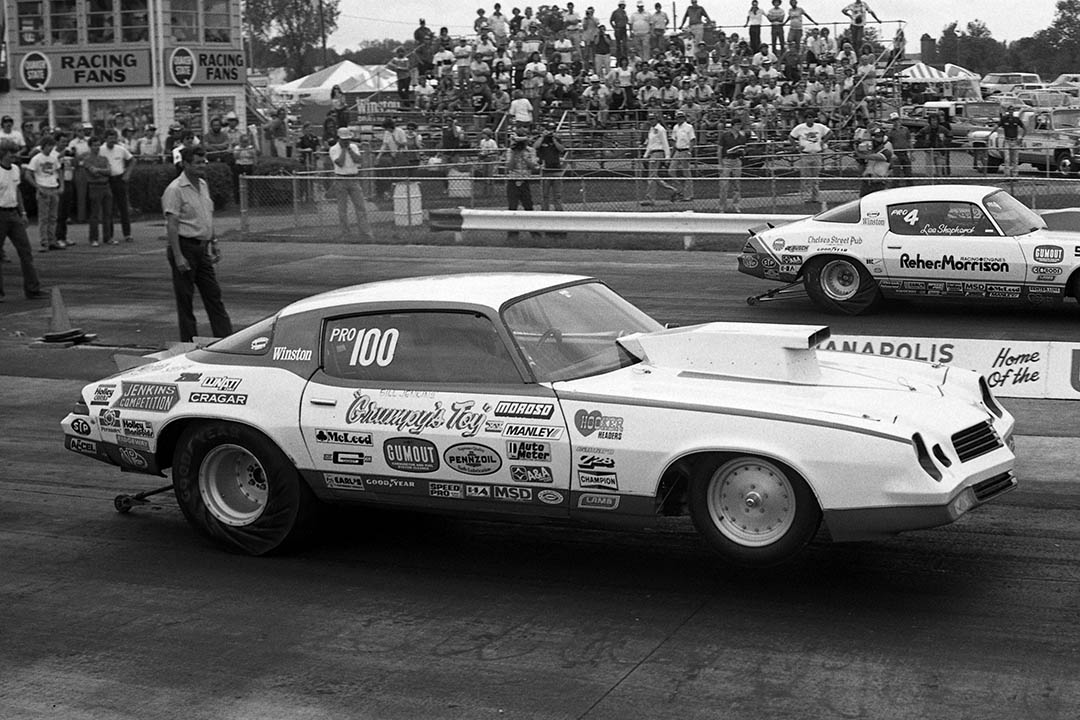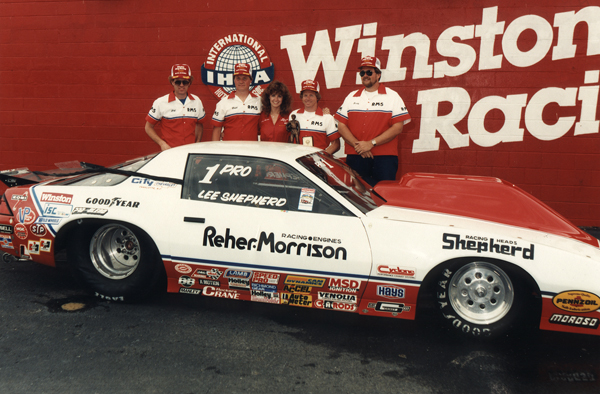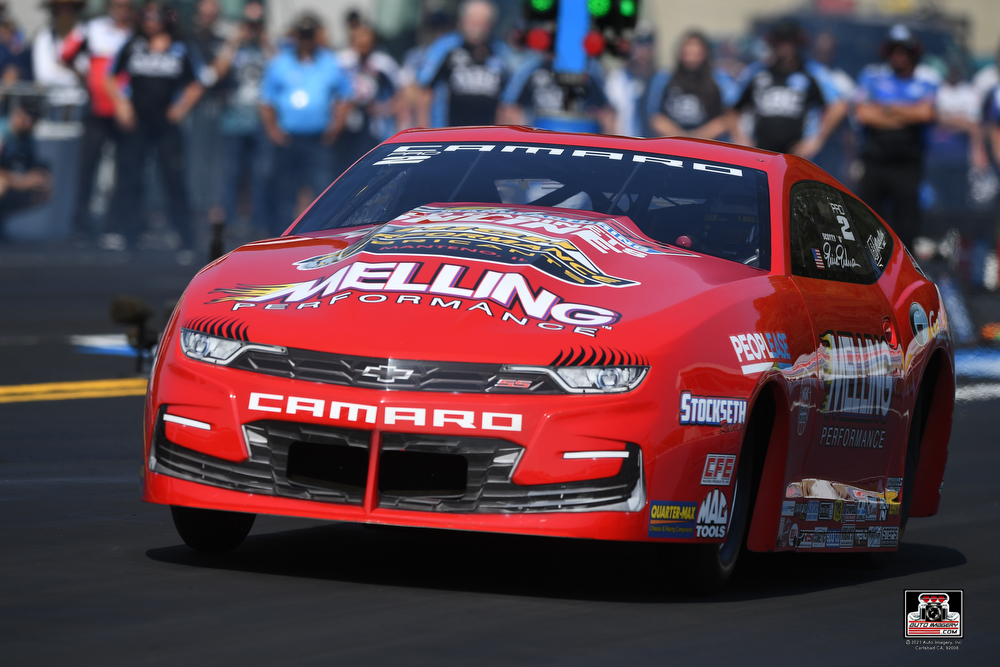ENCORE - WHY DID THE CAMARO TAKE OVER PRO STOCK? BECAUSE IT WAS BUILT TO DO SO

Do you ever wonder why the Camaro is virtually everywhere in drag racing and dominates Pro Stock in entries? It's not rocket science; the Chevrolet has been the Bowtie brand's all-time largest-selling sports car. There have been 5.5 million Camaros sold since 1967, even after taking off eight years of production.
Chevy fans can thank Ford Motor Company and their Mustang for the Camaro. The Camaro became a response, although not immediately. General Motors wasn't worried about the Mustang and initially felt their Corvair was an adequate response and a superior car. They were greatly mistaken.
Ford Mustang sales topped 100,000, and while GM redesigned their Corvair, they quickly learned it wasn't even in the ballpark. The Corvair sold only 73,000 units. The combination of declining Corvair sales and a book by Ralph Nader, Unsafe At Any Speed, pushed the Camaro into production at warp speed.
One thing that set the Camaro apart early on was the use of computer programming. In a 1979 article, Hot Rod Magazine confirmed that the computer design enabled GM Engineers to design a superior-handling suspension in a fraction of the time a conventional program would have yielded. Additionally, the Camaro was also designed by the same team responsible for the 1968 Corvette.
Early on, this concept was referred to as the F-car, and GM even flirted with the name "Panther" before settling on the Camaro at the last moment.
Concept artists also created fastback versions, a two-seater convertible, and a two-door station wagon design. In the end, management decided only to produce a coupe and a convertible.
Hot Rod got the ball rolling for the Camaro by accepting one of the new sporty hot rods as a project car in June 1966. Then-editor Jim McFarland made his way around the manufacturers in California with the ride, seeking specially built parts for the forthcoming machine.
 Since there was no such thing as the internet and social media, McFarland didn't worry about showing off the car because his and the other automotive publications carried a three-month lead time.
Since there was no such thing as the internet and social media, McFarland didn't worry about showing off the car because his and the other automotive publications carried a three-month lead time.
The first Camaros hit the showroom floors in September 1966, and its 375-hp, 396-cubic-inch (6.5-liter) L78 big-block made it an immediate player.
At the 1967 NHRA U.S. Nationals, the Camaros swept the Stock and Super Stock categories. It was the brothers Ben and Dave Wentzel whose decision to buy the 302-inch, 290-horse, 4-speed Camaro proved a far wiser choice than their contemplated 375-horse Chevelle. The decision also made them forever a part of drag racing history.
If the question ever arises, who won the first race in a Camaro? It was the Wentzels, a full 10 minutes before drag racing icon Bill "Grumpy" Jenkins, who was second in his Super Stock/C entry, stopping Bob Brown.
Ironically, it was Jenkins who would also be the first to lose to a Camaro when he red-lighted in the first round of the Super Stock/C class eliminations at the NHRA Winternationals, driving his famous Chevy II. Jenkins lost to the HOT ROD Project Car, with Don Evans driving. A source close to the situation revealed if only NHRA had P&G'd the HOT ROD car, it might have revealed a 480-inch powerplant and not the factory 396.
 Three years later, Jenkins would open the new Pro Stock class with the first two victories and did so behind the wheel of a Camaro.
Three years later, Jenkins would open the new Pro Stock class with the first two victories and did so behind the wheel of a Camaro.
The Camaro looked to be the most long-term logical choice for body style in Pro Stock because it raced an engine combination that came from the factory with a V-8. Jenkins bypassed the Camaro and decided to forever alter the pathway for Pro Stock.
Jenkins came to Pomona with a Chevrolet Vega, and it was the first to hit the strip as a body style with an engine never matched in production. Regardless of what the Vegas won, it was never considered a factory hot rod.
"The Camaro was America's hot rod," noted drag racing historian Bret Kepner said. "The Vega was never America's anything and neither was Ford's Pinto, because neither one ever was manufactured with a V8 engine."
 The Camaro always had a V-8 option.
The Camaro always had a V-8 option.
Without an engine rule holding back the Vegas, the Camaro was pushed to the back burner as a choice because of its small and lighter stature. The Mustang felt the same rejection as the Pinto joined the Vegas as an equal sacrilege.
Plus, the Camaros were heavy at 3310 for a base model, while the Vega was 1,211 pounds lighter. The Camaro did have 11 inches more wheelbase.
By 1976, Chevrolet replaced the Vegas with the Monza, which was still lighter than the Camaro. At the time, it was very clear Detroit was intent on pushing gas economy over muscle which fell by the wayside with the 1974 - 1975 energy crisis.

The Camaro began to make its significant return into Pro Stock in 1978 and, by 1980, was in full swing. Having a Chevrolet-dominated entry list was nothing new for NHRA; even as far back as the 1980 NHRA U.S. Nationals, 23 of the 36 cars entered in Pro Stock were Bowties. Fourteen of those were Camaros, while five of those were Vegas and Monzas at the edge of the body rule.
Pat Musi was one of those Pro Stock drivers who stuck with the Camaro in the days when many went to the lighter Vegas and Monzas. Musi did go with a Monza in 1977 and raced it through 1980, but came back to the Camaro in 1981.
"It was the wheelbase that did it for us," Musi said. "At the time, I was a Camaro guy, and Lee Edwards had a Vega, and our rivalry was serious. I wasn't going to run the same kind of car as him.

"Plus, to us, the overhang on the Camaros made the difference. Early on, we didn't understand how important the overhang was and how to use it in our favor. Once that became apparent in 1980, we all took advantage of it with a Camaro."
When the Gen 3 Camaro came along, if you raced a Chevrolet, you raced a Camaro. The Camaro was eventually replaced by the Beretta and later Lumina as Chevrolet ceased production of the car in 1992.
Until this point, Chevrolet Pro Stock racers, aside from the Camaro, had battled in a Nova, Vega, Monza, Cavalier, Chevette, Citation, and Monte Carlo [in IHRA and AHRA Pro Stock]. A significant name in Chevrolet's muscle lineup was missing from the list.
There's a reason why the Corvette never raced in Pro Stock.
Its classification as a sports car was never legal for Pro Stock. The Corvette was manufactured as a two-seater and had more than 50 percent of the weight on the rear wheels.

Likely, the Corvette might have been the most popular car in Pro Stock ever, except for the aforementioned weight transfer issue. Most American-manufactured cars had more than 50 percent of the weight on the nose and front wheels. Corvettes were produced 52/48, 48 on the front, which produced a considerable advantage.
In a very extensive article written in 2020 by National DRAGSTER editor Phil Burgess, in collaboration with DragList.com's Bill Pratt, he confirmed the Camaro accounted for over 25 percent of entries in NHRA Pro Stock alone.
The Chevrolet Camaro returned to NHRA Pro Stock in 2012 when Greg Stanfield drove Greg Hill's new entry to the semi-finals at the NHRA Las Vegas Nationals in April of that year.
The Chevrolet Camaro had won 241 of the 530 contested NHRA national events. Here's a little tidbit to leave you with, the last time someone won an NHRA Pro Stock national event was in November 2017.
When NHRA created its box standard, the Camaro body style provided the best and only option for Chevrolet drag racers when it came along.
And it appears the only way to stop the Camaro onslaught is to do what Chevrolet did, as the manufacturer announced that the 2024 version would be its last offering of the Camaro.
The NHRA hasn't held steadfast to its body style rule in years, so there's no reason the Camaro can't keep on winning.
sources: Hot Rod Magazine, September 1979, Bret Kepner, Rick Voegelin







































